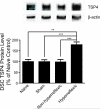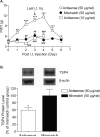Thrombospondin-4 contributes to spinal cord injury-induced changes in nociception
- PMID: 23649982
- PMCID: PMC3762950
- DOI: 10.1002/j.1532-2149.2013.00326.x
Thrombospondin-4 contributes to spinal cord injury-induced changes in nociception
Abstract
Background: Our previous data have indicated that nerve injury-induced up-regulation of thrombospondin-4 (TSP4) proteins in dorsal spinal cord plays a causal role in neuropathic pain state development in a spinal nerve ligation model. To investigate whether TSP4 proteins also contribute to the development of centrally mediated changes in nociception after spinal cord injury (SCI), we investigated whether SCI induced TSP4 dysregulation, and if so, whether this change correlated with changes in nociception in a T9 spinal cord contusion injury model.
Methods: Behavioural sensitivity to mechanical, thermal stimuli and locomotor function recovery were tested blindly in SCI or sham rats post-injury. Intrathecal antisense or mismatch control oligodeoxynucleotides were used to treat SCI rats with nociceptive hyperreflexia, and Western blots were used to measure TSP4 protein levels in dorsal spinal cord samples.
Results: SCI induced below-level hindpaw hypersensitivity to stimuli. TSP4 protein levels are up-regulated in dorsal spinal cord of SCI rats with nociceptive hyperreflexia, but not in SCI rats without nociceptive hyperreflexia. There was no significant difference in motor function recovery post-injury between SCI rats with or without nociceptive hyperreflexia. Intrathecal treatment with TSP4 antisense, but not mismatch control, oligodeoxynucleotides led to reversal of injury-induced TSP4 up-regulation and nociceptive hyperreflexia in SCI rats.
Conclusions: SCI leads to TSP4 up-regulation in lumbar spinal cord that may play a critical role in mediating centrally mediated behavioural hypersensitivity. Blocking this pathway may be helpful in management of SCI-induced changes in nociception.
© 2013 European Federation of International Association for the Study of Pain Chapters.
Figures



Similar articles
-
Trigeminal nerve injury-induced thrombospondin-4 up-regulation contributes to orofacial neuropathic pain states in a rat model.Eur J Pain. 2014 Apr;18(4):489-95. doi: 10.1002/j.1532-2149.2013.00396.x. Epub 2013 Sep 9. Eur J Pain. 2014. PMID: 24019258 Free PMC article.
-
Thrombospondin-4 contributes to spinal sensitization and neuropathic pain states.J Neurosci. 2012 Jun 27;32(26):8977-87. doi: 10.1523/JNEUROSCI.6494-11.2012. J Neurosci. 2012. PMID: 22745497 Free PMC article.
-
Calcium channel alpha-2-delta-1 protein upregulation in dorsal spinal cord mediates spinal cord injury-induced neuropathic pain states.Pain. 2011 Mar;152(3):649-655. doi: 10.1016/j.pain.2010.12.014. Epub 2011 Jan 15. Pain. 2011. PMID: 21239111 Free PMC article.
-
Regional Hyperexcitability and Chronic Neuropathic Pain Following Spinal Cord Injury.Cell Mol Neurobiol. 2020 Aug;40(6):861-878. doi: 10.1007/s10571-020-00785-7. Epub 2020 Jan 18. Cell Mol Neurobiol. 2020. PMID: 31955281 Free PMC article. Review.
-
When Pain Hurts: Nociceptive Stimulation Induces a State of Maladaptive Plasticity and Impairs Recovery after Spinal Cord Injury.J Neurotrauma. 2017 May 15;34(10):1873-1890. doi: 10.1089/neu.2016.4626. Epub 2016 Dec 20. J Neurotrauma. 2017. PMID: 27788626 Free PMC article. Review.
Cited by
-
Effects of cyanocobalamin and its combination with morphine on neuropathic rats and the relationship between these effects and thrombospondin-4 expression.Korean J Pain. 2022 Jan 1;35(1):66-77. doi: 10.3344/kjp.2022.35.1.66. Korean J Pain. 2022. PMID: 34966013 Free PMC article.
-
Acute post-injury blockade of α2δ-1 calcium channel subunits prevents pathological autonomic plasticity after spinal cord injury.Cell Rep. 2021 Jan 26;34(4):108667. doi: 10.1016/j.celrep.2020.108667. Cell Rep. 2021. PMID: 33503436 Free PMC article.
-
Spinal Astrocytic Thrombospondin-4 Induced by Excitatory Neuronal Signaling Mediates Pain After Facet Capsule Injury.Ann Biomed Eng. 2016 Nov;44(11):3215-3224. doi: 10.1007/s10439-016-1639-x. Epub 2016 May 9. Ann Biomed Eng. 2016. PMID: 27160673 Free PMC article.
-
Expression of thrombospondin-4 in the infrapatellar fat pad and synovial fluid - potential contribution to osteoarthritis pain.Arthritis Res Ther. 2025 Aug 26;27(1):170. doi: 10.1186/s13075-025-03615-7. Arthritis Res Ther. 2025. PMID: 40859337 Free PMC article.
-
Direct, gabapentin-insensitive interaction of a soluble form of the calcium channel subunit α2δ-1 with thrombospondin-4.Sci Rep. 2019 Nov 7;9(1):16272. doi: 10.1038/s41598-019-52655-y. Sci Rep. 2019. PMID: 31700036 Free PMC article.
References
-
- Ataoglu E, Tiftik T, Kara M, Tunc H, Ersoz M, Akkus S. Effects of chronic pain on quality of life and depression in patients with spinal cord injury. Spinal Cord. 2012;51:23–26. - PubMed
-
- Baastrup C, Maersk-Moller CC, Nyengaard JR, Jensen TS, Finnerup NB. Spinal-, brainstem- and cerebrally mediated responses at- and below-level of a spinal cord contusion in rats: evaluation of pain-like behavior. Pain. 2010;151:670–679. - PubMed
-
- Basso DM, Beattie MS, Bresnahan JC. A sensitive and reliable locomotor rating scale for open field testing in rats. J Neurotrauma. 1995;12:1–21. - PubMed
-
- Bornstein P, Agah A, Kyriakides TR. The role of thrombospondins 1 and 2 in the regulation of cell-matrix interactions, collagen fibril formation, and the response to injury. Int J Biochem Cell Biol. 2004;36:1115–1125. - PubMed
Publication types
MeSH terms
Substances
Associated data
- Actions
Grants and funding
LinkOut - more resources
Full Text Sources
Other Literature Sources
Medical
Molecular Biology Databases
Miscellaneous

